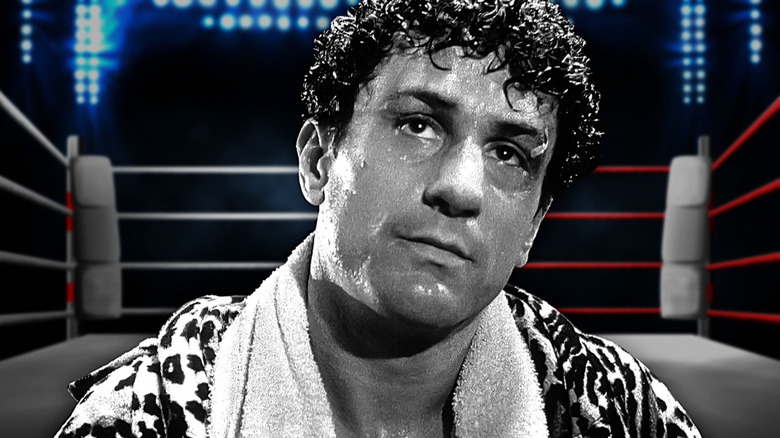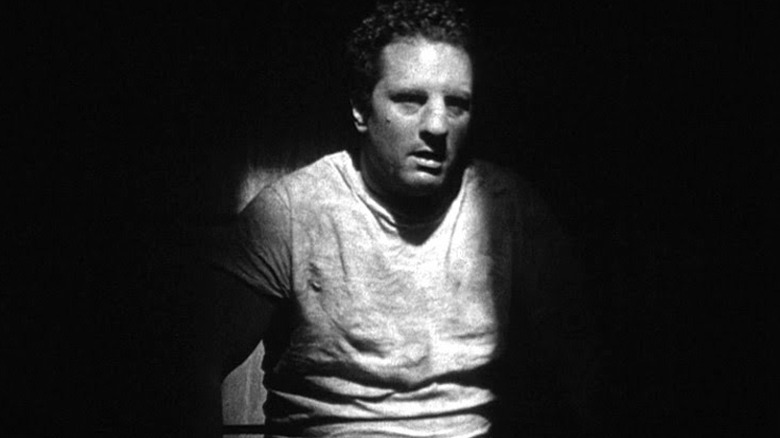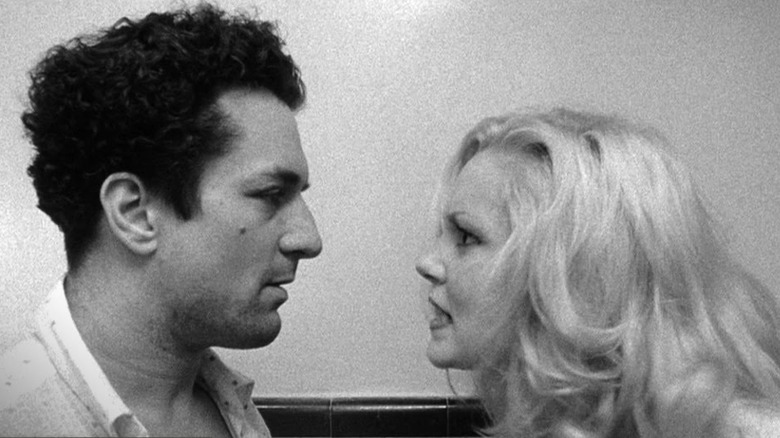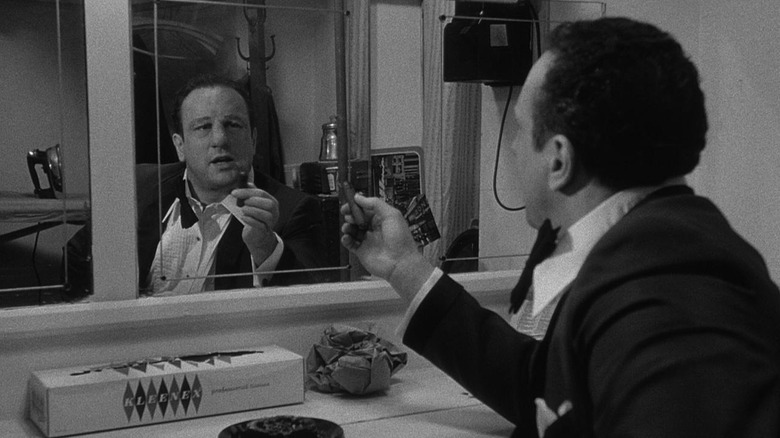One Of Robert De Niro's Best Movies Almost Didn't Get Made
During the 2021 Tribeca Film Festival, Robert De Niro and Martin Scorsese discussed their fourth film together, "Raging Bull," with moderator Leonardo DiCaprio. It's a brutal piece of cinema that uses black-and-white cinematography to reflect middleweight boxer Jake LaMotta's grim outlook on the world as he finds success and quickly loses it. Violence and anger course through his veins, and LaMotta barrels through life outside the ring like a bull in a china shop — destroying everything and everyone in his path. Although it became regarded as one of Scorsese and De Niro's finest works, "Raging Bull" had a rocky journey to the screen.
De Niro first became fascinated with Jake LaMotta's story after reading his memoir, "Raging Bull: My Story," and approached Martin Scorsese with the idea of adapting it all the way back in 1974, but they were both unsure of how it would be received. How could a raw and ugly portrayal of an abusive boxer resonate with moviegoers? "We didn't know how well it was going to do, but we knew it would be special. No matter what, it would be special. It just could not not be because of everything we put into it," De Niro told Tribeca audiences. The actor-director duo endured heavy blows to bring the project to life, from constructing the script to the filming process and eventual release.
A personal crisis convinced Scorsese to make Raging Bull
Martin Scorsese initially had hesitations about directing "Raging Bull" because he found boxing, and sports in general, to be tedious:
"I wasn't affected by the book at all. Also, nothing against sports, but having had severe asthma and [being] told I couldn't run, I couldn't do this, I couldn't laugh . . . I was very sheltered and it kept me from any team sports, which is sad in one way, but on the other hand it made me focus on imagination. I went to a lot of movies" (via EW).
But in 1979, Scorsese had a revelation about Jake LaMotta's life story that came from his own drug-related overdose. As reported in The New Yorker, Robert De Niro visited Scorsese in the hospital after his near-death experience and pitched "Raging Bull" again as a potentially life-saving project. De Niro knew that if Scorsese could pour all his artistic ambition into the shared goal of making this redemptive story, he would have a reason to greet each new day.
Scorsese gained a deeper emotional understanding of LaMotta's self-destruction because it mirrored his own struggles with addiction and recovery; he could now view "Raging Bull" as something more than just a typical boxing movie. "I was lost in a way, so I had to start all over again. It was a rebirth in a way," he told Tribeca audiences. Like LaMotta, Scorsese could not control his overwhelming impulses and hit rock bottom. Channeling his depleted energy into creative expression was the only way he could climb back up. It is Scorsese's intimate awareness of humanity's darkest behavior that makes "Raging Bull" such a gritty and visceral masterpiece.
The battle for the best screenplay
It took years and a devastating event for Robert De Niro to finally convince Martin Scorsese to adapt "Raging Bull," but crafting the screenplay was another tough fight. Mardik Martin, who had also written "Mean Streets," wrote a draft that they disliked, so they brought in "Taxi Driver" scribe Paul Schrader. "I hated to do it after all the time Mardik spent, but there was much more boxing than we wanted," Scorsese told The Observer.
Schrader's version was far more rough, featuring a scene where Jake LaMotta attempts to masturbate in his jail cell that risked an X rating. The final version of that scene, where Jake LaMotta weeps "I'm not an animal" then vents his frustrations by pounding the concrete wall over and over and over again, became one of the most gut-wrenching moments in "Raging Bull," and powerful enough without the added sexuality. Scorsese and De Niro ended up spending a few weeks on the island of Sint Maarten to restructure the screenplay.
The memoir covers a lot of ground that the final film ends up ignoring, such as Jake's teenage years of robbery, reform school, and the sexual assault of his best friend's girlfriend. Instead, "Raging Bull" concentrates on what fascinated Robert De Niro the most about Jake LaMotta's life: his body transformation. "I said, 'Jesus, look what happened to him.' And I thought the graphic difference of being out of shape and then being a young fighter really was interesting," he told the Independent. Jake LaMotta was a very physically and emotionally demanding role ... although, putting on 60 pounds by taking a food tour of France and Italy doesn't sound so bad.
Reinventing the boxing ring
Another hurdle to making "Raging Bull" for Martin Scorsese was that there were already many classic films about troubled boxers with emotional problems, such as "The Champ," "Somebody Up There Likes Me," and "Body and Soul." One of the ways in which Martin Scorsese set "Raging Bull" apart was its kinetic boxing sequences:
"In a lot of other boxing films, the camera's outside the ring and you see through the ropes. I said, 'What if you're in the ring and you're the boxer? How do you see things and hear things?' We stretched time — we had to use some slow motion because some things were so fast — but pretty much all the shots were invented while we were shooting it. The camera was in the fist at one point" (via EW).
These pulsating fight scenes focus on a protagonist who harshly juxtaposes the underdogs that audiences enjoy rooting for in earlier boxing films. Jake LaMotta exemplifies the type of complex and ethically questionable male characters that Scorsese and De Niro love to explore together. LaMotta is a brash hurricane of destruction, pain, and narcissism; yet, we are still engrossed by his story. This is what the acting and directing duo does best, from their earliest collaboration ("Taxi Driver") to their latest ("Killers of the Flower Moon"). They are a dream team and "Raging Bull" is just one cinematic miracle of their partnership, now regarded as one of Robert De Niro's best performances and Martin Scorsese's best films.



